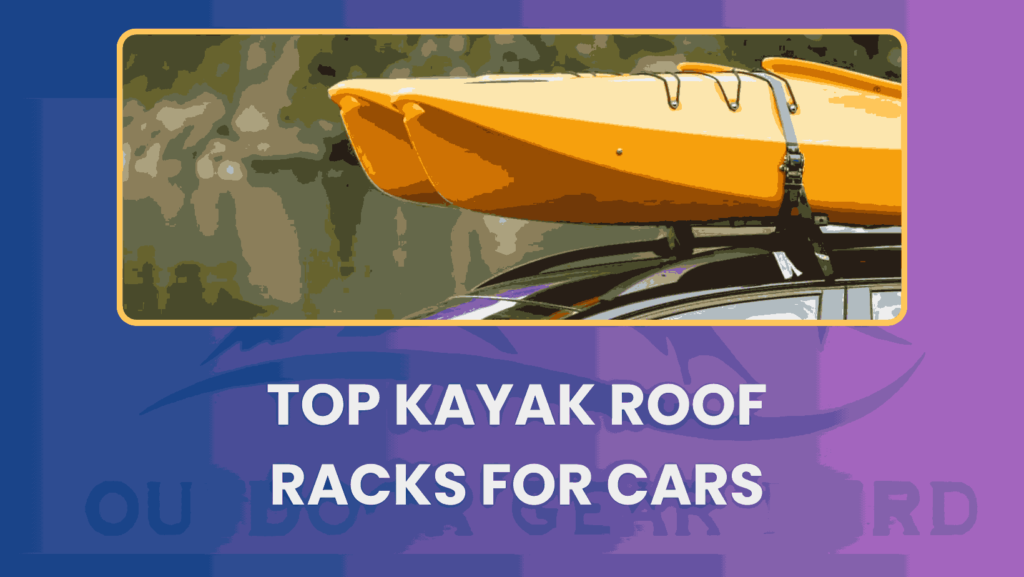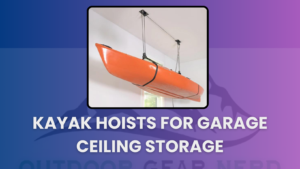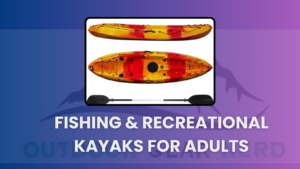
Finding the Perfect Kayak Rack for Cars Without Rails
Looking for the ideal kayak rack for your car without rails? We’ve done the research and found options to fit every budget, from affordable to premium. Not having roof rails shouldn’t deter your adventures. Here are the best kayak racks for cars without rails, ensuring you have a sturdy and secure way to transport your kayak.
Types of Kayak Racks for Cars Without Rails
Before diving into product reviews, it’s important to understand the different styles of kayak racks available for cars without rails:
- Clamp Attach Crossbars: These crossbars attach directly to the car’s roof using clamps. They’re popular due to their sturdiness and ability to mimic the traditional rail system.
- Strap and Suction Attach Crossbars: These crossbars use straps that go inside the car doors to secure the system. Some models also employ vacuum towers, which create a strong suction on the car’s roof, ensuring the crossbars remain firmly in place.
- Soft Roof Rack Pads: Perfect for occasional users, these pads cushion the kayak and protect the roof of your car. They’re easy to install and remove.
- Inflatable Roof Racks: A newer option, these racks are inflated when needed, making them convenient and space-saving.
- Foam Blocks: A straightforward and budget-friendly choice, foam blocks sit directly on your car’s roof. You place the kayak on top and secure it with straps. For more on this method, see our guide on how to transport a kayak without a roof rack.
No matter your budget or needs, there’s a kayak rack option that’s perfect for you, ensuring your kayak adventures are safe and hassle-free.
Our Top Choices
- Best Overall Rack for Cars Without Rails: Thule Evo Clamp + WingBar Evo
- Best Budget-Friendly Crossbars: Malone VersaRail Bare Roof Cross Rail System
- Best Soft Roof Rack Pads: Yakima EasyTop Universal Roof Rack
- Best Inflatable Roof Rack: HandiRack Universal Inflatable Soft Roof Rack Bars
1. Best Overall Rack for Cars Without Rails: Thule Evo Clamp + WingBar Evo
Specifications:
- Color: Black
- Brand: Thule
- Dimensions (L x W x H): 1 x 1 x 1 inches
- Foldable: No
- Load Capacity: 165 Pounds
- Mounting Type: Rack
- GTIN: 00091021181298
- Manufacturer: Thule
- UPC: 091021181298
This item includes a set of four load carrier feet designed specifically for the Thule Evo roof rack system, with load bars and fit kits sold separately. Installation is straightforward as the foot mounts directly onto vehicles without pre-existing roof rack attachment points. An ergonomic torque limiter key ensures that the rack is securely and properly attached.
The quick assembly process features click-in mounting brackets, eliminating the need for additional tools. Patented clamping technology guarantees a secure fit, and the system can be locked with Thule One-Key locks (sold separately).
Compatible with Thule WingBar Evo, Thule AeroBlade, Thule SquareBar, and Thule ProBar, this rack supports a maximum load of 165 lbs. Be sure to verify your vehicle’s maximum roof load capacity before use. For optimal compatibility, consult the Thule Buyer’s Guide.
Pros:
- Easy Installation: Tool-free assembly and click-in mounting brackets simplify the installation process.
- Secure Fit: Patented clamping technology and torque limiter key ensure a safe and secure attachment to the vehicle.
- Versatility: Compatible with various Thule load bars for customization.
- Durability: Corrosion-resistant coating enhances longevity.
Cons:
- Additional Components Required: The Evo Clamp is just one part of the roof rack system; load bars and fit kits are sold separately.
- Price: As a premium brand, the Evo Clamp might be more expensive compared to other options.
2. Best Budget-Friendly Crossbars: Malone VersaRail Bare Roof Cross Rail System
Specifications:
- Brand: Malone
- Dimensions (L x W x H): 50 x 8 x 5.75 inches
- Load Capacity: 135 Pounds
- Mounting Type: Railing Mount, Strap Mount
- GTIN: 00855265004627
- Manufacturer: Malone
- UPC: 855265004627
- Vehicle Service Type: Car
- Material: Composite
- Item Weight: 10.5 Pounds
- Foldable: No
The Malone VersaRail is a versatile, easy-to-install roof rack system designed for vehicles without existing rails. Its 50-inch length and 135-pound load capacity make it suitable for a range of cargo, from bikes and kayaks to cargo boxes. The system includes vacuum towers with strong suction cups and safety straps for secure attachment to your vehicle’s roof. Its corrosion-resistant coating ensures durability, while the rectangular shape offers compatibility with most rack accessories.
Key features include a tool-free installation process, a sturdy build, and a five-year warranty.
Pros:
- Versatility: Suitable for a variety of cargo, from bikes to kayaks to cargo boxes.
- Easy Installation: Tool-free assembly and secure mounting system.
- Durability: Corrosion-resistant coating for long-lasting use.
- Affordability: Generally considered a budget-friendly option compared to premium brands.
Cons:
- Load Capacity: 135-pound capacity might be limiting for heavier loads.
- Potential for Noise: Vacuum-based mounting systems can sometimes create wind noise at higher speeds.
- Vehicle Compatibility: May not be suitable for all vehicle roof types or shapes.
3. Best Soft Roof Rack Pads: Yakima EasyTop Universal Roof Rack
Specifications
- Best Use: Travel, Watersports, Snowsports
- Weight: 4 lbs. 8 oz.
This versatile roof rack is designed to fit almost any vehicle, effortlessly transforming it into a functional roof rack capable of carrying up to 80 lbs. of long, flat gear. It features thick structural padding to protect both your vehicle’s roof and your equipment, while the double-latching buckle ensures additional security. Installation is quick and straightforward, taking only a few minutes; the integrated straps loop through your car’s door frames and fasten securely with the buckle. Its portability makes it ideal for travel, allowing you to easily attach it to rental vehicles. The rack comes complete with two heavy-duty straps and a tie-down rope for added convenience and reliability.
The Yakima EasyTop Universal Roof Rack is a standout choice for those seeking a blend of convenience and practicality without the commitment of permanent fixtures.
The true allure of the Yakima EasyTop lies in its simplicity. It embodies user-friendliness in its purest form—no tools or complex manuals are required. Installation is as effortless as fastening a seatbelt, allowing virtually any car to carry up to 80 lbs of gear, from kayaks to skis.
Its sleek design minimizes drag, but the real highlight is the thoughtful padding that protects both your vehicle and gear. The generous cushioning safeguards against scratches and dents, while the double-latching buckle ensures secure transport, offering peace of mind even on rough roads.
However, the Yakima EasyTop does have a few considerations. The strap design, while supportive, may intrude into your car’s cabin, which could be bothersome for taller passengers. Additionally, persistent rain might pose a challenge, as the strap design can direct water inside the car.
In summary, the Yakima EasyTop Universal Roof Rack is ideal for occasional adventurers or those who value flexibility without permanent installations. Its balance of affordability, ease of use, and adaptability makes it a compelling option. For frequent kayakers or those dealing with diverse weather conditions, a more permanent rack, such as those from Thule, might be a better fit.
Pros:
- Portability and Convenience: Lightweight, easy to install and remove without tools.
- Versatility: Suitable for a variety of cargo, including kayaks, skis, and surfboards.
- Cost-Effective: Generally more affordable than permanent roof rack systems.
- Vehicle Protection: Padding protects both the vehicle and cargo from damage.
Cons:
- Weight Capacity: Lower weight capacity compared to permanent roof racks.
- Potential for Wind Noise: May create more wind noise than traditional roof racks.
- Limited Stability: Might not be as stable as permanent roof racks, especially at higher speeds.
- Weather Sensitivity: Can be affected by adverse weather conditions, such as heavy rain.
4. Best Inflatable Roof Rack: HandiRack Universal Inflatable Soft Roof Rack Bars
Specifications:
- Color: Black
- Brand: HandiRack
- Item Dimensions (L x W x H): 14.6 x 7.4 x 5.7 inches
- Load Capacity: 175 Pounds
- Mounting Type: Strap
- Global Trade Identification Number: 05060158520008
- Manufacturer: HandiRack
- UPC: 783847209651
- Material: Nylon
- Item Weight: 5.8 Pounds
- Is Foldable: Yes
- Vehicle Service Type: 4×4, SUV, Car, Coupe, Hatchback, Compact, Crossover, Station Wagon, Sedan
The HandiRack Universal Inflatable Roof Rack is designed to simplify transporting your gear with ease and efficiency. Ideal for a range of vehicles, including cars and SUVs, this versatile roof rack supports a substantial 175-pound load capacity, making it perfect for carrying kayaks, canoes, paddle boards, surfboards, snowboards, and skis.
Installation is straightforward and tool-free, with the rack mounting in just minutes. It features five metal ‘D’ ring anchor points for secure attachment, ensuring your gear stays firmly in place. The inflatable design is well-suited for cars without rails as well as those with rails and panoramic roofs. Its aero design pads help reduce vibrations and wind noise during transit.
The HandiRack comes fully equipped with everything you need right out of the box: two HandiRack twin tubes, a HandiPump for easy inflation, two 10-foot tie-down straps, two 11-foot bow and stern lines, and a drawstring storage bag. For added convenience, it’s portable and easily removable, though it’s recommended to remove it when not in use.
This roof rack is compatible with a wide range of vehicle models from brands such as Audi, BMW, Chevrolet, Ford, Honda, and many more. However, it is not suitable for vehicles with soft tops or side curtain airbags. Backed by a one-year guarantee against manufacturing defects, the HandiRack offers a reliable and efficient solution for your roof rack needs.
Buying Guide: Factors to Consider
Choosing the right kayak rack for cars without rails can be overwhelming. To simplify your decision-making process, here’s what to consider:
Ease of Use Ease of installation and convenience are crucial. Here’s a breakdown of different styles:
- Foam Pads: These are the simplest to use. Just lay them on your car’s roof, place your kayak on top, and secure with straps. They require no tools and are highly intuitive.
- Inflatable Racks: Racks like the HandiRack need a pump for inflation but are quick to set up and deflate. They are portable and easy to store.
- Crossbar Racks: Though initially more complex, crossbar racks, such as the Thule Evo Clamp + WingBar Evo, offer a more permanent solution once you’re familiar with the system. They might be ideal if you’re looking for stability and regular use.
Durability Durability is a key factor, as you want a rack that lasts. Consider these points:
- Material Quality: Crossbar racks from reputable brands like Thule are built with high-grade materials for longevity. However, budget-friendly options can still be durable if well-maintained.
- Maintenance: Regular inspections for damage, cleaning to remove grime, and proper storage when not in use can extend the life of your rack. Ensure fittings are secure but not overtightened to avoid stress.
Cost The price of kayak racks varies based on their type and features:
- Foam Blocks: These are the most affordable, typically costing between $20 to $60. They’re suitable for occasional use but may lack stability.
- Inflatable Racks: Priced between $50 to $150, they offer flexibility and ease of use, balancing cost and functionality.
- Soft Roof Rack Pads: Usually ranging from $100 to $200, these provide more stability and are ideal for occasional to regular use.
- Crossbar Racks: These premium options can range from $150 to over $500. Brands like Thule and Yakima offer durability and stability, often with added features like aerodynamic design for better fuel efficiency.
Consider your budget, frequency of use, and the need for convenience versus stability. A durable rack is an investment in safety and ease of transport, paying off in the long run with fewer replacements and peace of mind on every trip.
Pros:
- Portability: Lightweight, compact, and easily stored when not in use.
- Versatility: Suitable for a wide range of vehicles and cargo types.
- Easy Installation: Quick and tool-free setup.
- Durability: Made from durable materials for long-lasting use.
- Cost-Effective: Generally more affordable than traditional roof racks.
Cons:
- Load Capacity: Lower load capacity compared to some traditional roof racks.
- Potential for Wind Noise: May generate more wind noise than solid roof racks, especially at higher speeds.
- Vehicle Compatibility: While designed for universal fit, it might not be ideal for all vehicle types or roof shapes.
How to Install a Roof Rack on a Car Without Rails
Installing a clamp-style crossbar roof rack can be more complex than other styles, so here’s a detailed guide to ensure a secure fit:
- Prepare the Feet: Gather all components and identify each foot’s position based on any labels or indicators (e.g., front left, rear right). Attach any protective rubber or padding to each foot to safeguard your car’s roof from scratches and ensure a snug fit.
- Attach the Crossbars: Slide each foot onto the ends of the crossbars. Ensure they are aligned correctly. Some racks feature a release mechanism or button to assist with this step.
- Adjust the Scale (if applicable): Many clamp-style racks come with a scale or measuring device. Adjust this scale according to the manufacturer’s instructions to align the crossbars properly.
- Position the Rack: Place the assembled rack (crossbars with feet) onto your car’s roof. Use a measuring tape to follow the manufacturer’s guidelines for optimal spacing between the front and rear bars. This ensures the rack is correctly positioned and securely placed.
- Tighten the Rack: Begin tightening the feet to secure the rack to your car. Some racks come with a tool or indicator to show when the rack is tight enough, preventing over-tightening which could damage your vehicle.
- Final Touches: Once the rack is secure, attach any end caps or covers. These not only complete the look but also help reduce wind noise. If available, consider adding lock cylinders or other security features for added protection.
- Safety Check: Perform a final safety check by ensuring the rack is firmly in place and doesn’t move when nudged.
Always refer to the manufacturer’s installation guide for specific instructions and safety precautions to ensure a secure and proper fit.
Frequently Asked Questions
1. Can You Put a Roof Rack on Any Car?
Answer: Absolutely! Modern roof racks are designed to be highly versatile, accommodating a wide range of vehicles, including compact sedans, spacious SUVs, and everything in between. Roof racks are available in various styles and mounting options to suit vehicles with or without existing roof rails. However, it’s crucial to consult the manufacturer’s guidelines or use a roof rack compatibility checker to ensure the chosen rack fits your specific vehicle model and meets its weight capacity. This ensures a secure and safe installation for all your gear.
2. What Are the Benefits of Using a Universal Roof Rack for Cars Without Rails?
Answer: Universal roof racks offer several advantages for car owners:
- Adaptability: Designed to fit a wide range of vehicle types, universal roof racks are ideal for households with multiple cars or varying vehicle models.
- Cost-Effectiveness: They provide a budget-friendly alternative to permanent roof rails, offering similar functionality without the high cost or commitment.
- Ease of Installation: Universal roof racks are generally easy to install and remove, often requiring no tools. This makes them a practical choice for those who need occasional use without permanent modifications.
- Space-Saving Design: Many universal racks feature designs that can be disassembled or folded when not in use, saving valuable storage space and preventing them from becoming a permanent fixture on your vehicle.
- Versatility: These racks can be used for a variety of gear, including bikes, kayaks, skis, and cargo boxes, making them a versatile solution for different needs and activities.
Universal roof racks combine convenience, flexibility, and affordability, making them a popular choice for many car owners.
3. Do I Need Crossbars for Kayak Mounts?
Answer: Yes, crossbars are typically necessary for mounting specialized kayak racks, such as J-cradles, saddle mounts, or stackers. These racks attach securely to the crossbars, providing a stable and secure platform for transporting your kayak.
While temporary solutions like foam pads or inflatable racks can be used to transport kayaks, they do not support the attachment of specialized kayak mounts. Instead, these temporary options involve placing the kayak directly on the roof, with straps used to secure it, without the need for additional crossbars.
Conclusion
Selecting the right kayak rack is crucial—it goes beyond merely transporting your kayak. A quality rack ensures your kayak’s safety, protects your vehicle, and gives you peace of mind during every journey.
When choosing the best kayak rack, consider your specific needs and the nature of your adventures. Are you an occasional paddler looking for flexibility without a permanent setup? Or are you a dedicated kayaker who needs a reliable, robust solution for frequent use?
For a blend of durability, functionality, and sleek design, the Thule Evo Clamp + WingBar Evo is an excellent choice. If you’re working within a budget, the Malone VersaRail or Yakima EasyTop provide solid performance at a more affordable price. For innovative and convenient options, the HandiRack Universal Inflatable Soft Roof Rack Bars offer a unique and practical solution. Choose the rack that best fits your lifestyle and enjoy your time on the water with confidence.




